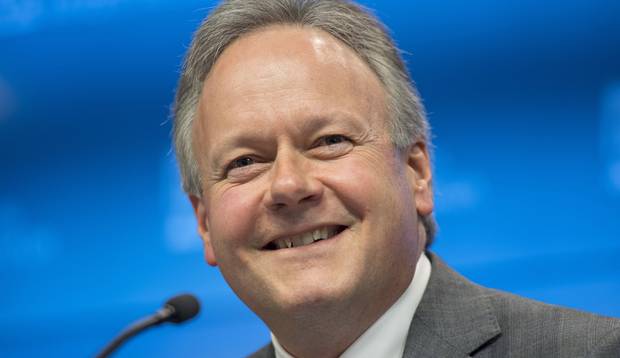Briefing highlights
- What to expect from the Bank of Canada
- Markets at a glance
- Laurentian finds mortgage ‘misrepresentations’
- Hudson’s Bay posts wider-than-forecast loss
- Bitcoin tops $12,000

Bank of Canada governor Stephen Poloz speaks at a news conference after release of the financial system review in Ottawa, Nov. 28, 2017
JUSTIN TANG/THE CANADIAN PRESS
Stephen Poloz is finally getting some of what he wants.
But it won't change the minds of the Bank of Canada Governor and his colleagues today.
The central bank is widely expected to hold its benchmark overnight rate steady at 1 per cent, following its two earlier hikes this year and then its switch to wait-and-see mode last time out.
Among other things, the Bank of Canada wants to see the impact of those two earlier increases, along with developments at the NAFTA bargaining table.
But Mr. Poloz is seeing action on at least two fronts: Trade and consumer debt. And while the latest readings are fairly short-term, and you can't take such measures as gospel going forward, at least it's action.
On Tuesday, for example, Statistics Canada reported that the country's trade deficit narrowed sharply in October, with exports rebounding after four lame months, as the central bank wants. It was still a deficit, of $1.5-billion, but that was down from September's $3.5-billion and was driven by a 2.7-per-cent gain in exports.
"It was a horror story for real Canadian exports in the third quarter, a major reason why growth for that trimester was half of Q2's pace," said Nick Exarhos of CIBC World Markets.
"But the October reading on trade gives us reason to hope for an acceleration in the last quarter of the year."
Having said that, the Bank of Canada was already projecting an economic pick-up in the fourth quarter, and "estimates were already baking in some stronger figures from manufacturing and two-way trade," Mr. Exarhos added.
"As a result, even if the numbers nudge up our tracking estimate for October monthly GDP, it's not yet enough to decisively change our outlook on the timing of the next Bank of Canada rate hike."
Which won't be today, but could be soon, nonetheless, some observers believe.
"This [trade] report, combined with last week's stellar employment report, will be looked favourably upon by the data-dependent Bank of Canada," said Toronto-Dominion Bank economist Dina Ignjatovic.
"With most areas of the economy evolving as expected by the bank, higher interest rates are not far off."
The other biggie is household debt, where Canada ranks among the world leaders.
It's elevated - Canadians owe $1.68 for every dollar of disposable income - but policy makers and the commercial bank regulator have taken steps to cool the housing and mortgage markets. And Mr. Poloz sees some progress.
"Household indebtedness continues to be the most important vulnerability for the financial system, especially given the large share of debt held by highly indebted households," the central bank said in its latest review.
"Policy changes to housing finance, higher interest rates and growth in household income should continue to mitigate this vulnerability over time. The pace and degree of these developments are, however, uncertain.
The Bank for International Settlements, which is made up of the world's central banks, is also seeing progress, though being out of the woods would be quite a stretch.
In its latest report this weekend, the BIS noted that a key early-warning signal for financial crises eased in the second quarter, though banking strains are still a risk.
It's known as the credit-to-GDP gap, which looks at the ratio of debt to gross domestic product, compared with its long-term showing. Canada dipped below the threshold of 10 in the second quarter, to 9.4, which means the country is now 9.4 percentage points above that longer average.
So, as Citigroup economist Dana M. Peterson put it in a report this week, "what is the BoC waiting for?"
"The bank should have plenty to like about current economic conditions and prospects for both the global and domestic economies," Ms. Peterson said, though it's probably "most perturbed by weak inflation, persistent household imbalances related to debt and housing, and highly indebted consumers becoming squeezed by rising interest rates."
Which makes this morning's policy decision key for markets going forward. Not the do-nothing stance, but the language.
"The more interesting aspects will be the BoC's assessment of current economic conditions and, importantly, what it is waiting to see in order to feel confident about raising interest rates further," Ms. Peterson said.
The Fitch Ratings agency, in turn, said it expects the Bank of Canada to "tread cautiously" before raising rates again.
"Inflation is well anchored, and both core and headline measures are around 1.5 per cent, stubbornly below the 2-per-cent midpoint of the target inflation range," Fitch said Tuesday.
"Unit labour costs are falling, particularly in the resource sector, with Canada experiencing its own version of a phenomenon seen elsewhere: a tightening labour market accompanied by low wage growth. The bank also believes that potential growth has risen slightly following higher-than-expected investment. We expect it to wait until 2018 before raising rates again."
Read more
- Export sector shows signs of life as trade deficit shrinks
- Janet McFarland: Tougher mortgage rules could shut out 50,000 potential home buyers a year: report
- Threat of Canadian financial crisis eases (but don’t take that to the bank)
- Barrie McKenna: New mortgage rules could disqualify 10% of buyers with big down payments: Bank of Canada
- Mortgage sticker shock: Get ready to pay more on renewal, possibly through the nose
- Housing affordability: It’ll be far nastier in Toronto and Vancouver as rates rise this time
- 2018 consumer math: 2% inflation + 1.4% pay raise = you’re screwed
Markets at a glance
Read more
More news
- Laurentian Bank audit finds ‘client misrepresentations’ on some mortgages
- Hudson’s Bay posts wider-than-forecast loss as sales fall
- Bitcoin surges above $12,000 to record on relentless demand